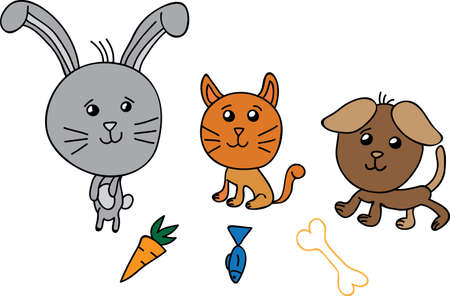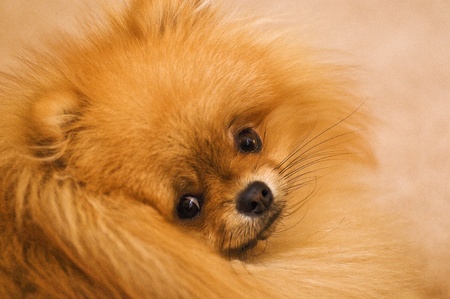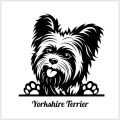1. Why Brushing Your Pet Matters
Regular brushing is an essential part of pet care, whether you have a dog or a cat. Not only does it keep their coat looking clean and shiny, but it also provides several health benefits. Understanding why brushing matters can help you choose the right brush and establish a grooming routine that keeps your pet happy and healthy.
Reduces Shedding
One of the biggest concerns for pet owners is shedding. Regular brushing helps remove loose fur before it ends up on your furniture, clothes, and floors. This is especially important for breeds that shed heavily, such as Golden Retrievers or Maine Coons.
Prevents Matting and Tangles
Matted fur can be painful for pets and lead to skin infections if not addressed. Long-haired breeds, like Persian cats or Shih Tzus, are particularly prone to tangles. Using the right brush regularly helps prevent mats from forming and keeps your pet’s coat smooth.
Promotes Healthy Skin
Brushing isn’t just about the fur—it also stimulates blood circulation and distributes natural oils across the skin. This helps prevent dryness and irritation while keeping your pet’s coat soft and healthy.
Types of Brushes and Their Benefits
Different pets have different grooming needs, so choosing the right brush is crucial. Here’s a quick overview of common types of brushes and what they do:
| Brush Type | Best For | Benefits |
|---|---|---|
| Slicker Brush | Long-haired dogs & cats | Removes tangles, prevents matting |
| Bristle Brush | Short-haired pets | Distributes natural oils, adds shine |
| Deshedding Tool | Heavy shedders (Labradors, Huskies) | Reduces shedding by removing loose undercoat hair |
| Pin Brush | Pets with medium to long fur | Gentle detangling, removes loose fur |
| Rubber Brush | Short-haired dogs & cats | Massages skin, removes loose hair effectively |
How Often Should You Brush Your Pet?
The frequency of brushing depends on your pet’s breed and coat type. Here are some general guidelines:
- Short-haired breeds: 1-2 times per week to remove loose hair.
- Medium-haired breeds: 2-4 times per week to prevent tangles.
- Long-haired breeds: Daily brushing to avoid mats and knots.
Making Brushing a Positive Experience
If your pet is not used to being brushed, start slowly and use positive reinforcement. Offer treats and gentle praise to create a pleasant experience. Choosing the right brush will also make the process more comfortable for them.
A regular brushing routine will keep your pet’s coat in great shape while strengthening your bond with them. In the next section, we’ll take a closer look at the different types of dog and cat brushes available.
2. Slicker Brushes: Best for Removing Tangles and Mats
Slicker brushes are a must-have grooming tool for pet owners dealing with medium to long-haired dogs and cats. These brushes are designed to remove tangles, mats, and loose fur while keeping your pet’s coat smooth and healthy.
How Do Slicker Brushes Work?
Slicker brushes have fine, short wires set close together on a flat or slightly curved surface. These bristles help detangle hair, remove loose fur, and prevent matting by gently brushing through the coat without causing discomfort.
Ideal Coat Types for Slicker Brushes
Not all pets need a slicker brush, but they work exceptionally well for certain coat types. Here’s a quick guide:
| Coat Type | Recommended for Slicker Brushes? |
|---|---|
| Short Hair | No, better suited for bristle or rubber brushes |
| Medium Hair | Yes, helps prevent tangles and mats |
| Long Hair | Yes, essential for keeping the coat smooth and mat-free |
| Curly or Wavy Hair | Yes, great for preventing knots and maintaining shape |
Best Way to Use a Slicker Brush
Using a slicker brush correctly ensures your pet stays comfortable while benefiting from regular grooming. Follow these steps:
Step 1: Start Gently
Began by lightly brushing in the direction of hair growth. Avoid pressing too hard to prevent skin irritation.
Step 2: Focus on Problem Areas
Matted areas behind the ears, under the legs, and around the tail should be brushed carefully using short strokes.
Step 3: Use Short Strokes
If you encounter knots, use short strokes instead of pulling to avoid discomfort.
Step 4: Reward Your Pet
Praise and give treats after grooming to make the experience positive.

3. Bristle and Pin Brushes: Everyday Grooming Essentials
Bristle and pin brushes are must-have tools for everyday grooming. They help maintain your pet’s coat by distributing natural oils, removing loose hair, and keeping fur looking smooth and healthy. Whether your pet has short or medium-length fur, these brushes provide gentle care while preventing tangles and minor mats.
How Bristle Brushes Work
Bristle brushes have tightly packed soft or firm bristles that help remove dirt and debris while stimulating the skin. They work best for pets with short coats or those with smooth fur that doesn’t tangle easily.
Benefits of Bristle Brushes
- Distributes natural oils for a shiny coat
- Removes surface dirt and loose hair
- Provides a gentle massage to improve circulation
- Works well for short-haired dogs and cats
How Pin Brushes Work
Pin brushes feature widely spaced metal pins with rounded tips that glide through fur without scratching the skin. These brushes are great for pets with medium-length coats or light tangles.
Benefits of Pin Brushes
- Easily detangles light knots and mats
- Gently removes loose hair without pulling
- Keeps medium-length coats fluffy and smooth
- Suitable for long-haired cats and dogs as a finishing brush
Bristle vs. Pin Brushes: Which One to Use?
| Brush Type | Best For | Main Benefits |
|---|---|---|
| Bristle Brush | Short-haired pets | Smooths coat, removes dirt, distributes oils |
| Pin Brush | Medium-length or lightly tangled coats | Eases tangles, removes loose hair, keeps fur fluffy |
Tips for Using Bristle and Pin Brushes Effectively
- Brush in the direction of hair growth to avoid discomfort.
- Use gentle strokes to prevent irritation, especially on sensitive areas.
- If using both brushes, start with the pin brush to remove tangles, then finish with the bristle brush for shine.
- Aim for daily brushing to keep shedding under control and promote healthy skin.
Bristle and pin brushes are essential tools for maintaining a pet’s coat between professional grooming sessions. By incorporating them into your pet’s routine, you can keep their fur looking clean, smooth, and well-maintained.
4. Deshedding Tools: Controlling Excess Fur
If you have a dog or cat that sheds a lot, deshedding tools can be a game-changer. These tools are specifically designed to remove loose fur from the undercoat, significantly reducing the amount of hair that ends up on your furniture and clothes.
How Do Deshedding Tools Work?
Deshedding tools, like the popular Furminator, use fine metal teeth to reach deep into the undercoat without damaging the topcoat. Unlike regular brushes that only skim the surface, these tools help prevent excessive shedding by removing dead hair before it falls out naturally.
Best Breeds for Deshedding Tools
Not all pets need deshedding tools, but they are particularly useful for breeds with thick undercoats. Here are some common high-shedding breeds that benefit from regular deshedding:
| Dogs | Cats |
|---|---|
| Labrador Retriever | Maine Coon |
| German Shepherd | Persian |
| Siberian Husky | Ragdoll |
| Golden Retriever | British Shorthair |
| Corgi | Siberian |
When and How Often Should You Use a Deshedding Tool?
The best time to use a deshedding tool is during shedding seasons—typically spring and fall—when pets naturally lose more fur. However, depending on your pet’s coat type, you may need to use it year-round. Here’s a general guideline:
| Coat Type | Recommended Frequency |
|---|---|
| Short-haired breeds (e.g., Beagle, Domestic Shorthair Cat) | Once every 2-3 weeks |
| Medium-haired breeds (e.g., Border Collie, Siamese Cat) | Once per week |
| Long-haired breeds (e.g., Golden Retriever, Maine Coon) | 2-3 times per week |
| Heavy shedders (e.g., Husky, Persian Cat) | Every other day during peak shedding seasons |
Tips for Using a Deshedding Tool Effectively
1. Brush in the Direction of Hair Growth
Avoid pulling or tugging by gently brushing in the direction your pet’s fur naturally grows.
2. Don’t Overuse It
Using a deshedding tool too often can irritate your pet’s skin. Stick to the recommended frequency based on their coat type.
3. Use on a Dry Coat
For best results, make sure your pet’s coat is completely dry before using a deshedding tool.
4. Follow Up with a Regular Brush
A slicker brush or bristle brush can help remove any remaining loose hairs after using a deshedding tool.
The Bottom Line on Deshedding Tools
If you struggle with excessive pet hair in your home, investing in a high-quality deshedding tool like the Furminator can make a noticeable difference. By using it correctly and regularly, you can keep your pets coat healthy while minimizing shedding around your house.
5. Rubber and Glove Brushes: Gentle Grooming for Sensitive Pets
When it comes to grooming pets with short hair or those that are sensitive to traditional brushes, rubber and glove brushes offer a comfortable and effective solution. These types of brushes provide a gentle way to remove loose fur, dirt, and dander without irritating your pet’s skin.
Why Choose Rubber and Glove Brushes?
Rubber and glove brushes are designed to be soft and flexible, making them perfect for pets that dislike stiff bristles or metal pins. They work by using static and friction to lift away loose hair while also providing a soothing massage effect.
Benefits of Rubber and Glove Brushes
| Feature | Benefit |
|---|---|
| Soft and Flexible Material | Gentle on sensitive skin, reducing irritation |
| Massage Effect | Improves circulation and promotes relaxation |
| Easy to Clean | Hair clumps together for effortless removal |
| Great for Short-Haired Pets | Effectively removes loose fur without pulling |
| User-Friendly Design | Glove brushes allow for easy control and comfort |
How to Use Rubber and Glove Brushes Effectively
Select the Right Brush Type
If your pet enjoys being petted more than brushed, a grooming glove might be the best option. For pets that tolerate brushing but need something gentle, a rubber brush is a great choice.
Use Gentle Circular Motions
Avoid harsh strokes—rubber brushes work best when used in circular motions. This helps loosen dirt, remove shedding fur, and distribute natural oils evenly across the coat.
Clean the Brush Regularly
Since these brushes collect hair easily, make sure to remove accumulated fur after each use. Some rubber brushes can even be rinsed with water for easy maintenance.
Best Pets for Rubber and Glove Brushes
- Cats: Especially those with short coats or sensitive skin.
- Dogs: Ideal for breeds like Beagles, Boxers, Dachshunds, and other short-haired dogs.
- Nervous or Anxious Pets: The massage-like sensation can help calm anxious pets during grooming sessions.
The Perfect Choice for a Stress-Free Grooming Routine
If your pet dislikes traditional brushes or has sensitive skin, rubber and glove brushes provide an excellent alternative. Not only do they effectively remove loose hair, but they also turn grooming into a relaxing experience for your furry friend.


